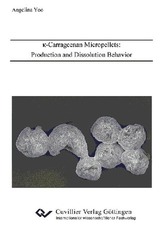| Departments | |
|---|---|
| Book Series (96) |
1378
|
| Nachhaltigkeit |
3
|
| Gesundheitswesen |
1
|
| Humanities |
2365
|
| Natural Sciences |
5406
|
| Mathematics | 229 |
| Informatics | 319 |
| Physics | 980 |
| Chemistry | 1363 |
| Geosciences | 131 |
| Human medicine | 243 |
| Stomatology | 10 |
| Veterinary medicine | 108 |
| Pharmacy | 147 |
| Biology | 835 |
| Biochemistry, molecular biology, gene technology | 121 |
| Biophysics | 25 |
| Domestic and nutritional science | 45 |
| Agricultural science | 1004 |
| Forest science | 201 |
| Horticultural science | 20 |
| Environmental research, ecology and landscape conservation | 148 |
| Engineering |
1793
|
| Common |
98
|
|
Leitlinien Unfallchirurgie
5. Auflage bestellen |
|
Advanced Search
k-Carrageenan Micropellets: Production and Dissolution Behavior (English shop)
Angelina Yoo (Author)Preview
Table of Contents, Datei (43 KB)
Extract, Datei (91 KB)
This is the first report of a systematic investigation on the production of micropellets (500 µm to 700 µm median diameter). In general, κ-carrageenan is a suitable pelletization aid to produce spherical aggregates by wet extrusion/ spheronization. The obtained pellets show fast drug release, which is advantageous for use with slightly soluble drugs.
The mechanism of spheronization for micropellets differed to that for bigger pellets. The conditions for spheronization reported for bigger pellets could not be used to produce micropellets. The optimization of the process parameters for producing micropellets was performed on two different types of spheronizers.
The dissolution behavior of the micropellets containing κ-carrageenan and different APIs was investigated in terms of the effects of ionic interactions. To evaluate the ionic interactions, different chloride salts such as sodium chloride or calcium chloride, among other dissolution media, were added. The different cations used are generally known as ‘specific’- and ‘non-specific’- binding ions to the κ-carrageenan. A correlation was found between the dissolution behavior of micropellets comprising κ-carrageenan and the classification of the dissolved ions. When the ratio between API and κ-carrageenan in the micropellets was varied, a relation between the dissolution rate and the solubility of the API was shown. The dissolution rate of soluble drugs was not affected by the ratio resulting in fast drug release independent of the media. In contrast, the dissolution profiles of micropellets comprising κ-carrageenan and either very slightly soluble or practically insoluble drugs were dependent on the concentration of the ions. For example, drug release from micropellets comprising κ-carrageenan was slower with increasing amounts of calcium ions in the dissolution media. Matrix dissolution of the anomalous (non-Fickian) diffusion type was obtained. The dissolution behavior was affected by ionic interactions. The correlation between the ratio of API and κ-carrageenan only existed when ionic solutions such as calcium chloride were used as the dissolution media and not with deionized water. Further investigations with practically insoluble drugs showed that the API was a key determinant on the dissolution behavior. By means of a model, the relation between the dissolution behavior of micropellets, the solubility of the API and the ionic interactions with κ-carrageenan was described.
In addition, the effects of different fillers on the dissolution behavior of micropellets were investigated. The type and the amount of filler affected the dissolution behavior. The drug release was improved in the presence of water-soluble lactose monohydrate. However, the effect of the solubility of the fillers was negligible on the dissolution behavior when the amount of API was increased and the amount of filler was decreased.
In conclusion, the results of this thesis showed that fast dissolving micropellets were produced by wet extrusion/ spheronization. However, the drug release is strongly dependent on the formulation and the conditions of the dissolution media. Based on the extensive analysis of the ionic interactions on κ-carrageenan it is possible to explain the dissolution behavior of micropellets in the presence of ions, which enables conclusions about food interactions to be drawn. Based on this, measures to improve the availability of the drug can be initiated.
| ISBN-13 (Printausgabe) | 3867278547 |
| ISBN-13 (Hard Copy) | 9783867278546 |
| ISBN-13 (eBook) | 9783736928541 |
| Final Book Format | A5 |
| Language | English |
| Page Number | 146 |
| Edition | 1 Aufl. |
| Volume | 0 |
| Publication Place | Göttingen |
| Place of Dissertation | Universität Düsseldorf |
| Publication Date | 2009-01-14 |
| General Categorization | Dissertation |
| Departments |
Pharmacy
|
| Keywords | κ-carrageenan, micropellets, production, extrusion/ spheronization, CCC-design, statistical evaluation, dissolution, ionic interactions, spironolactone, theophylline monohydrate, hydrochlorothiazide, griseofulvin, itraconazole |








